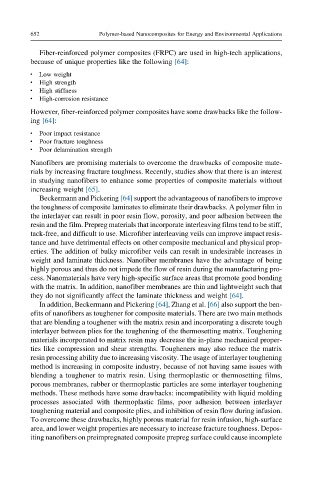Page 709 - Polymer-based Nanocomposites for Energy and Environmental Applications
P. 709
652 Polymer-based Nanocomposites for Energy and Environmental Applications
Fiber-reinforced polymer composites (FRPC) are used in high-tech applications,
because of unique properties like the following [64]:
l Low weight
l High strength
l High stiffness
l High-corrosion resistance
However, fiber-reinforced polymer composites have some drawbacks like the follow-
ing [64]:
l Poor impact resistance
l Poor fracture toughness
l Poor delamination strength
Nanofibers are promising materials to overcome the drawbacks of composite mate-
rials by increasing fracture toughness. Recently, studies show that there is an interest
in studying nanofibers to enhance some properties of composite materials without
increasing weight [65].
Beckermann and Pickering [64] support the advantageous of nanofibers to improve
the toughness of composite laminates to eliminate their drawbacks. A polymer film in
the interlayer can result in poor resin flow, porosity, and poor adhesion between the
resin and the film. Prepreg materials that incorporate interleaving films tend to be stiff,
tack-free, and difficult to use. Microfiber interleaving veils can improve impact resis-
tance and have detrimental effects on other composite mechanical and physical prop-
erties. The addition of bulky microfiber veils can result in undesirable increases in
weight and laminate thickness. Nanofiber membranes have the advantage of being
highly porous and thus do not impede the flow of resin during the manufacturing pro-
cess. Nanomaterials have very high-specific surface areas that promote good bonding
with the matrix. In addition, nanofiber membranes are thin and lightweight such that
they do not significantly affect the laminate thickness and weight [64].
In addition, Beckermann and Pickering [64], Zhang et al. [66] also support the ben-
efits of nanofibers as toughener for composite materials. There are two main methods
that are blending a toughener with the matrix resin and incorporating a discrete tough
interlayer between plies for the toughening of the thermosetting matrix. Toughening
materials incorporated to matrix resin may decrease the in-plane mechanical proper-
ties like compression and shear strengths. Tougheners may also reduce the matrix
resin processing ability due to increasing viscosity. The usage of interlayer toughening
method is increasing in composite industry, because of not having same issues with
blending a toughener to matrix resin. Using thermoplastic or thermosetting films,
porous membranes, rubber or thermoplastic particles are some interlayer toughening
methods. These methods have some drawbacks: incompatibility with liquid molding
processes associated with thermoplastic films, poor adhesion between interlayer
toughening material and composite plies, and inhibition of resin flow during infusion.
To overcome these drawbacks, highly porous material for resin infusion, high-surface
area, and lower weight properties are necessary to increase fracture toughness. Depos-
iting nanofibers on preimpregnated composite prepreg surface could cause incomplete

